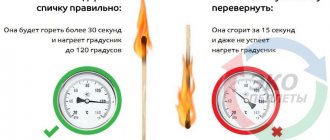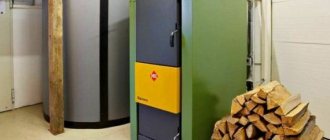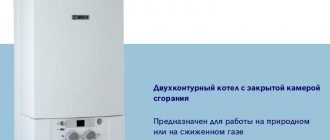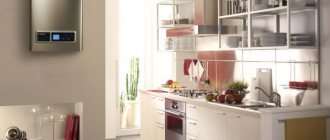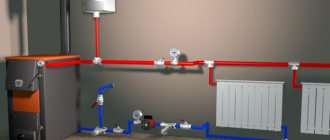Types of gas burners
Gas boilers differ in the type of combustion chamber. There is an open firebox - which must be equipped with a chimney to remove combustion products. The air for the combustion process in an open firebox comes from the environment. Therefore, units with such a combustion chamber are installed in a specially dedicated combustion chamber.
Gas boilers with a closed firebox differ from the open version. The burner is located inside a closed housing. The supply of air to the burner and the exhaust of smoke to the outside is ensured by a small coaxial chimney.
Gas burners are distinguished by the type of fuel on which they operate:
- for natural gas;
- for liquefied fuel;
- universal.
Most gas boilers are equipped with a universal burner that can operate on both natural and liquefied fuel.
Based on the number of power levels, burner devices are divided into:
- single-stage – capable of operating in only one mode;
- two-stage - have two power levels;
- modulation - capable of smoothly adjusting the flame strength in several modes.
How to set up a gas burner?
It is recommended to adjust the gas boiler burner flame using a gas analyzer. It records indicators of the air that participates in the process of fuel combustion: CO concentration, oxygen level, excess air ratio. The CO concentration should not exceed 50 ppm; oxygen is normally in the range of 3.6-5.3%. A lower oxygen content will lead to incomplete combustion of the fuel, a higher oxygen content will lead to a high concentration of CO2. Excess air can lead to an explosive situation, and its lack can lead to incomplete combustion of fuel, the formation of soot, soot and low efficiency.
The intensity of the fire can be observed through the viewing hole. The orange flame is too large, you can reduce it until it becomes almost invisible and has a bluish tint. Such a fire ensures optimal operation of the gas boiler. If you reduce the flame further, it will become completely invisible and then go out.
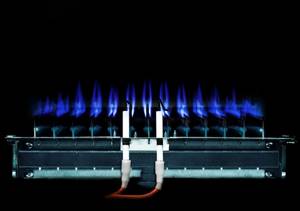
Regulation of the starting fuel supply works only at the moment of ignition and does not affect the operating efficiency. But if desired, it can also be adjusted: it is necessary to gradually reduce the starting flow, turning on the burner until it stops lighting up; then you need to increase the starting feed by turning the regulator in the opposite direction. The setup ends with checking that the burner is turned on.
If the flame burns with noise, you should reduce it using the regulator.
Why does a gas boiler smoke - reasons and solutions
Converting the burner to another type of gas
Only universal burner devices can be easily adapted to another type of fuel and do not require replacement of component parts. To switch to a different type of gas, the remaining burners need to replace the ramp, diaphragm, nozzles or manifold. Using the ramp, you can regulate the gas supply over a fairly wide range. In some cases, it is possible to adjust a burner operating on one type of fuel to burn on another type of gas. For example, switch from propane to methane and vice versa. When replacing propane with methane, the starting flow is first increased to ignite the gas, and then gradually reduced, as detailed in the previous section.
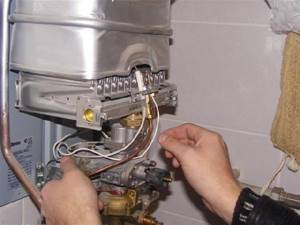
When switching to propane during initial startup with maximum fuel supply, a methane burner will smoke. It is adjusted by gradually reducing the fuel supply.
When converting a burner device from one type of fuel to another, it should be taken into account that the specific heat of combustion of propane is 1.5 times greater than that of natural gas - methane. So the power of a methane burner running on propane without replacing elements will increase. For example, a gas boiler with a power of 10-30 kW, when converted to propane, is capable of delivering a performance of 15-45 kW. However, the burner will not be able to produce more than 30 kW for a long time, as it will quickly overheat and fail. Therefore, the operating power range of the unit will be 15-30 kW.
Combination boilers - Models and design
___________________________________________________________________________
Unlike hot water boilers that operate on a single type of fuel, combination boilers require the use of multiple heat sources.
Usually this is gas and diesel fuel. Such generators are somewhat more expensive than single-fuel boilers, and their operating efficiency is 10-20% lower.
But at the same time, combination boilers are more reliable and durable than, for example, pure gas boilers. And interruptions in the gas supply, especially in winter, are not a problem for owners of combined boilers: it is always possible to replace one type of fuel with another. The disadvantages of combined boilers are different: the fuel pump, blower fan and other elements of such boilers operate from the electrical network, and interruptions in the power supply will inevitably lead to a stop in the operation of the heating equipment. If there is no electricity for a long enough time, then during the cold season there is a risk of freezing the water in the heating system.
To avoid the formation of condensation when burning diesel fuel, combined heat generators are usually made of cast iron. The German company has developed a special model of bimetallic combined boilers with double walls made of cast iron and steel. The inner surface of the boiler facing the flue gases is made of cast iron, and the surface facing the water is made of steel.
The bimetallic structure has less weight than cast iron. Combined boilers can be equipped with: - either two burners simultaneously: one for burning gas, the other for diesel fuel; - or one combined burner for both types of fuel. The design of a combination boiler with two burners makes it easy to dismantle one burner and install another in its place.
The burner is inserted into a special hole in the door or front of the boiler and secured with screws at the depth of the combustion chamber. Using a union nut, a gas or liquid fuel line is connected to the burner. After this, the tightness of the equipment is checked and air is removed from the line. The first start-up of the burner should be left in the hands of a specialist, since during it it is necessary to adjust the burner in accordance with environmental standards for the emission of pollutants into the atmosphere. The gas burner for a combination boiler is equipped with fan pressurization, thanks to which it is less vulnerable to fluctuations in gas pressure in the gas pipeline. If there is fan pressurization, the boiler can operate at a reduced gas pressure of up to 70-80 mm.
In the case of a single burner combi boiler, the gas and oil lines are connected to one burner, which simply switches from one type of fuel to the other. The design of combined burners is such that it simulates an equally round horizontal flame when burning any type of fuel. Combination burners are often equipped with an air valve with a servo drive, which helps save heat and promotes maximum fuel combustion.
The air valve prevents cooling of the combustion chamber during periods of boiler inactivity. When re-igniting a cooled boiler, the valve facilitates a smooth transition of the equipment to operating condition. The presence of an air valve is indicated by the marking in the burner model designation. In general, the cost of a boiler with a combined burner is much higher than the cost of a boiler designed for one type of fuel and even the cost of a combined boiler with a replaceable burner, so there are not so many boilers with combined burners on the Russian market. Weishaupt also offers combination burners for heating boilers. Universal boiler Flame Universal boilers Flame (Fig. 38) are single- and double-circuit steel boilers that operate on all types of fuel.
The modular design of these boilers allows you to quickly switch from one type of fuel to another. There are two doors on the front wall of the boiler: one for loading solid fuel, the second for supplying air to the firebox and for cleaning.
When the boiler operates on gaseous or diesel fuel, a burner (atmospheric or diesel, respectively) is installed instead of the second door. On the rear side of the boiler there are half-inch hot water supply pipes, a rectangular chimney and a two-inch pipe for connecting the return pipe of the heating system. Rice. 38. Boiler Flame 1 - thermometer; 2 - instantaneous water heater; 3 — pipe for installing the temperature sensor; 4 — turbulator; S - loading door; 6 - firebox; 7 - grate; 8 - blower; 9 — supply pipe nozzle; 10 — hot water pipe; 11 — cold water pipe; 12 - draft control valve installed in the chimney; 13 - casing; 14 — air gap (thermal protection); 15 - outer wall of the boiler; 16 — water jacket (coolant); 17 - inner wall of the boiler; 18 — return pipe When working with solid fuel, an air supply regulator is used that controls the intensity of fuel combustion, and an electric heating system that allows you to maintain a stable temperature between fuel loads. In addition, the electric heating system helps maintain a positive temperature in the room when the main heat source is turned off. Currently, three models of the universal Flame boiler are produced with different capacities: - model 12.5 for heating houses with an area of up to 120 m2, - model 20 for heating houses with an area of 120 m2 to 250 m2, - model 40 for heating houses with an area of 250 m2 up to 500 m2. All models can be used in heating systems with natural and forced circulation of coolant.
The advantages of the universal Flame boiler include low cost of equipment, low cost of installation work, ease of operation and heat savings (thanks to the electric heating system).
___________________________________________________________________________
___________________________________________________________________________
___________________________________________________________________________
- Malfunctions of the AOGV-23 ZhMZ boiler
- Parameters and design of gas boilers AOGV and AKGV
- Boiler automation Baxi Luna-3 Comfort
- Installation and installation of the Baxi Slim boiler
- Adjustments and maintenance of the Beretta Chao boiler
- Determination of error codes and malfunctions of Rinnai boilers
- Errors and malfunctions of the Termet gas boiler
- The meaning of error codes and malfunctions of Vailant boilers
- Determination of malfunctions and errors of Visman boilers
- Questions about servicing Navien boilers
- Questions about malfunctions of Kiturami diesel boilers
- Junkers boilers - Experts answer user questions
- Experts answer questions about Electrolux boilers
___________________________________________________________________________
___________________________________________________________________________
- Answers from Nova boiler repair experts
- Questions about Hermann boiler service
- Answers from Daewoo boiler service technicians
- Questions about servicing Ferroli boilers
- Questions from users regarding the repair of electric boilers Evan
- What causes an AKGV gas boiler to light up and immediately go out?
- What is wrong with the Alpha Color boiler if it shows error code E01
- Why does the AOGV boiler light up and go out quickly?
- How to eliminate error E01 on the Baltgaz boiler
- What is the problem if Dani’s boiler lights up but immediately goes out?
- Why does a Danko boiler light up but quickly go out?
- The Demrad boiler has stopped holding pressure, what is the problem?
- Why did the Gaslux boiler start to get hot and make noise?
- What is the reason if the Keber gas boiler lights up but quickly goes out?
- How to eliminate error code 01 on the Kiturami boiler
- What causes a Conord boiler to light up but immediately go out?
- What is the reason if the Lemax boiler lights up and goes out quickly
- Why does a Mimax boiler light up but suddenly go out?
- Why does the Hearth boiler light up but immediately go out?
- Why does a Ross gas boiler light up but go out quickly?
- What is the problem if the Siberia boiler lights up and goes out suddenly?
- Why does the boiler Signal light up and suddenly go out?
- What can cause a Termet boiler to make noise and get hot?
- Why does the Termotechnik gas boiler light up but suddenly go out?
- How can you eliminate error E01 on a Thermon boiler?
- For this reason, the Electrolux double-circuit boiler began to hum and heat up
- For what reasons does a Ferroli gas boiler display an error code A01?
- For what reason does the Immergaz boiler not operate on hot water supply?
- Why does the Navien gas boiler constantly turn off when heating and then turn on immediately?
___________________________________________________________________________
___________________________________________________________________________
___________________________________________________________________________
- Heating boiler piping
- STS boilers
- KVT boilers for solid fuel
- Pellet boiler Peresvet
- Steel floor standing boiler Raton
- Solid fuel boiler Thermology
- Errors and malfunctions of the Termet gas boiler
- Termona boiler repair
- Boiler repair Nova
- Hermann boiler service
- Comparison of gas boilers Lemax Premium-20 and Danko-20s
___________________________________________________________________________
- Daewoo boiler maintenance
- Demrad boiler malfunctions
- Mora boiler malfunctions
- Westen boiler repair
- Malfunctions of Immergaz boilers
- Types of solid fuel boilers
- Models and design of combination boilers
- Liquid fuel and double-circuit boilers
- Cast iron boilers on coal
- Boilers with modeling burners
- Imported boilers for heating systems
Adjusting a gas boiler: recommendations for setting up the device for correct operation
Can't find the instructions? Did the recommendations in the brochure not help you? You have the opportunity to read our article about setting up boilers. If you don't know how to handle gas equipment, you need a specialist. But you must admit, it doesn’t hurt to save time and money over and over again thanks to knowledge of the basic settings. Effectively adjusting a gas boiler is much simpler than it might seem.
From the article you will understand the principles of adjusting pressure, thrust and power during operation of the device. Find out the probable causes of problems along with options for eliminating them. If you need to tune the boiler, use our materials. Do not forget about the safety rules, and you will successfully configure the device and fix minor problems.
You should be interested in the settings of a gas boiler long before purchasing, taking into account your needs and various features. We have written which parameters can or should be changed in the device you are using. The new device should be configured and prepared for operation, and some undesirable aspects can be corrected.
Pricing policy for long-burning boilers
The price is determined based on many indicators and values, the main ones fit into three fundamental factors:
- Brand, country of origin;
- Characteristics of thermal power;
- Multifunctional design and ability to process various types of fuel.
By the way, long-burning wood-burning boilers from Stropuva with a power of 20 kW are in the price range of 1400-1900 euros. At the same time, similar power, but on a universal model, will cost 2000-2400 euros.
The classic is represented on the market by the Buderus long-burning boiler from a German concern. Operation is allowed on wood, coal, anthracite and pellets. The cost of the Buderus boiler is determined by the thermal output and ranges from 1400-1900 euros.
Let's add another EU manufacturer from Germany - the company's long-burning solid fuel boiler (Junkers) shows excellent performance. The Junkers boiler with a power of 32 kW with a price per unit of 1600 euros stands out from the range for the better.
The Viessmann company asks for the highest price for its long-burning pyrolysis boiler; for the Vitoligno model, the concern wants to receive from 2300 to 5900 euros for a boiler with a maximum industrial power of 80 kW.
It's time to turn to a domestic manufacturer. Available options start from 35 thousand rubles, so a Russian-made Cooper solid fuel boiler can be purchased for 40 thousand rubles.
Also on the Internet there is a huge amount of advice on how to make a long-burning solid fuel boiler with your own hands. If you have the material and skillful hands, you can create your own cauldron!
conclusions
In conclusion, we would like to say that you should not give in to the impulse to buy a long-burning solid fuel boiler, calculate all the options, and once again compare the calculations of the operating savings of an electric boiler. Try to clarify the necessary and sufficient power of the heat-generating equipment. Most likely, the issue price will be in the same range.
It is possible that an electric boiler, in combination with, say, a heated floor of a film type of infrared radiation, will be equally costly from a financial point of view in comparison with a long-burning boiler, but less troublesome to use. Well, if you decide that you can’t do without a long-burning boiler, don’t skimp and buy a device with automatic coal supply, it will greatly improve your life.
Setting up boiler automation and pressure
Reconfiguration is performed if the automation operates too often. This problem is called clocking, and it occurs due to an excessive increase in coolant temperature. Reduce the gas supply to the main burner, this will protect the boiler from wear.
The method also has a backup option - just twist the tap in front of the boiler. Remember that incomplete combustion of fuel leads to an increase in the volume of flue gases and smoke.
To get rid of clocking, move the room thermostat (if you have one) to a colder place or lower the air temperature at the installation site. Increase the amount of coolant in the heating system. Replace the main burner if clocking occurs due to its increased power.
Problems with automation and frequent shutdowns are observed under the following circumstances:
- voltage has dropped or jumped;
- a strong wind extinguished the burner;
- the permeability of the chimney has decreased;
- gas pressure has decreased.
To improve the operation of the automation, move the handle of the automatic block (gas valve) to the “spark” position. The igniter (pilot burner, pilot burner) will light up. Leave the knob in this position for 30 seconds, then return it to the “off” position - white circle.
Boilers are produced with thermostats (temperature regulators), daily and weekly programmers. The thermostat turns off the boiler when the set temperature is reached, then the device turns on automatically. While the owners are away, they can rely on a regulator with a 7-day operating period. The daily device eliminates the need for constant monitoring of the boiler.
The pressure is adjusted on the automatic block. For example, take Eurosit 630. The unit maintains the water temperature in the heating circuit and stops the gas supply in a dangerous situation. The Eurosit 630 has a handle that rotates and has 7 flame modes - move it to position “1”, remove the cover and tighten the screw on the left under the handle. Turn it clockwise - the gas supply will be smaller and smoother, and the automation will work better.
Also set the maximum mode. Point the knob at “7” and tighten the screw on the bottom of the unit, now counterclockwise. Reducing the flame level will reduce the gas pressure and the efficiency of the boiler burner at the same power setting.
First determine the required sides on the auto block. Consider the surface with the handle to be lateral. The unit is installed in different ways: sometimes this side is on the side, sometimes on top. Do not confuse the correct screws (gold plated) with the fasteners.
The pressure needs to be reduced in the following cases:
- the flame goes out soon after igniting;2
- there is a pop when igniting;
- the flame goes beyond its allotted limits;
- red or red-orange color of fire.
The pressure usually increases in winter: gas distribution companies raise the value from 200 to 280 mm water column. Install a pressure regulator or reduce the flow through the lowering.
What manufacturers of solid fuel boilers are hiding
A very interesting and informative article, although not ours. Some technical points are not fully disclosed, but it should be taken into account that the material was prepared by the consumer and for consumers.
With the advent of European changes, European prices for coolants gradually began to come to our country. Far-sighted owners of country houses began to look towards solid fuel boilers instead of gas ones, which, starting this fall, promise to become simply golden with such gas prices. And the market has become dramatically oversaturated. I have a feeling that only lazy people don’t sell solid fuel boilers now. There are so many of them that the number of manufacturers makes your head spin, and I’m generally silent about the names of the models.
This topic has become really relevant for me, since I myself am the owner of a small country house of 170 square meters, where I actually live. As a practical person, I first decided to find out everything in detail and monitor it. With my usual scrupulousness and mania for comparing information received from different sources, I set to work. You can see the result below. Hands down the memory of having a drink with the installation team, I can swear and declare with full responsibility that all the information below is true and reliable as it is entirely based either on personal observations, or on a scientific analysis of the data declared by the manufacturers, or on authoritative consultations. the same installation team.
All I managed to find out further is point by point:
Solid fuel boilers actually come in only four types. Classic , Pyrolysis, Top combustion and Pellet boilers
The classic one is a cauldron in which the flame burns from bottom to top, as in a regular fire. No matter where in the combustion chamber the ignition is carried out, after a short time the entire charge will simultaneously burn completely. The power of the flame itself must be regulated by something, otherwise it would be a banal potbelly stove. The standard control method is air supply control. For those who don’t understand what we’re talking about, let me explain: the more oxygen gets into the flame, the brighter it burns. Blacksmith's bellows, remember? There, due to the forced supply of air, the temperature on the coals rises to the temperature at which the ferrous metal becomes soft, by the way this is approximately 700 -1200 degrees. In solid fuel boilers, the same method is used but in the opposite direction. The flame is simply “smothered”, deprived of oxygen and thus the power is regulated until it smolderes. Naturally, this affects the temperature of the water that this boiler heats.
Pyrolysis is a boiler in which fuel, firewood, coal, etc. and flammable substances that come out of it during smoldering or combustion are burned separately. Essentially these are two cameras. In one, the fuel gradually smolders, releasing gas, and in the other, with the help of an air blower, the gas itself burns, heating the water. For reference: during the Second World War, the Germans had cars with pyrolysis boilers, a kind of micro-steam locomotive. I piled up some wood and went.
It’s true, this boiler has one very interesting feature. For proper work, or rather for work in general, he needs very, very dry firewood; he doesn’t want to work with damp wood. What if there is no dry firewood in winter??? Where can I get them???
A pellet boiler is a boiler that uses only one type of fuel - pellets (in some boilers it is possible to use ordinary firewood). The pellets are fed into the combustion chamber by a special mechanism from the bunker, and the combustion process itself takes place in a round burner where air is forced in.
The advantages of such a solid fuel boiler include a relatively long burning time between loads, limited only by the size of the bunker. In addition, pellets are not firewood, they are packaged by manufacturers in bags, there are no chips or dirt, the furnace room is always clean.
The disadvantage of pellet boilers is the high price of the boiler itself and the cost of pellets - they are more expensive than firewood. Another important point is the requirement for the quality of pellets. Ukraine has little good fuel, compressed from hardwood species, mainly pine, which means that the consumption of pellets will be higher.
A top-burning boiler is a boiler in which fuel is burned from top to bottom. The principle is quite simple - air is supplied only to the upper layer of the loading chamber, so combustion occurs in layers of 10 -15 cm. As soon as the layer has burned down, a special device for supplying air (telescope) is lowered below and the combustion process continues in the next layer. So all the way to the bottom. We’ve sorted out the principle, now let’s talk about the shortcomings and what manufacturers don’t talk about. Sorry, this is called marketing.
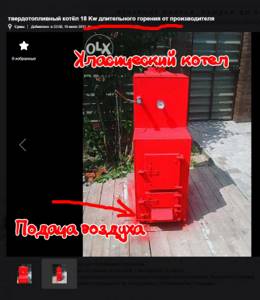
The most inconvenient thing about a solid fuel boiler is that it requires constant attention, it needs to be constantly loaded with fuel and the ash removed. And if you can’t afford to hire a fireman, you’ll have to do it yourself. Manufacturers are well aware of this and are trying to increase the time between loads as best they can.
The trend of the season is the phrase “ long-burning boiler ” is now written everywhere they can. True, mostly small, private producers.
Although in fact this phrase applies to only one type of boiler - a top-burning boiler. These boilers actually burn longer than others with the same load weight. The main sign is the air supply - if the air is supplied from below by opening the damper, this is not a long-burning boiler and the seller is blatantly lying to you.
The burning time of classic boilers is increased by converting them into pellet boilers using an auger - a mechanism for automatically feeding pellets. In this case, the actual burning time of the boiler on one load depends only on the size of the bunker in which the pellets are located. However, there are points: firstly, this greatly increases the cost of the solid fuel boiler itself, and secondly, pellets are significantly more expensive than firewood. Sometimes factory-made pellet boilers have a combustion chamber for firewood, but it is usually small and inconvenient.
Another important point that affects the combustion duration is the power the boiler produces. Power and combustion rate are interrelated concepts. Please note how the manufacturers write: Power up to 20 kW, burning time up to 30 hours. You see what you like and buy, although in fact in order for the boiler to produce 20 kW it must burn at maximum, which means there can be no talk of any 30 hours before the next load. A full load of a top-burning boiler (any fuel except coal) in this mode will burn out in 6 hours, well, maximum 7, if you load the chamber tightly and add tyres or wood chips. A classic boiler will delight you for no more than three hours.
Of course, it is possible to extend the combustion time. And as the installation foreman said, the boiler can really burn for up to 30 hours, but it definitely won’t be able to heat the water to a temperature of 60 - 65 degrees. Why do you need barely warm batteries??
But as they say, we cannot blame the manufacturer for fraud, since everything written is true. Can the boiler produce 20 kW? - Maybe! Can the boiler burn for 30 hours? - Maybe! You will not find a phrase where these two characteristics are interconnected in any description of the boiler. Marketing…
According to the same installers, you need to find a balance here. The boiler must be selected so that it operates at 70 - 80% of its full power, then the batteries will be warm and there will be no condensation with acid (from the low temperature in the furnace, below 50 degrees, boilers do not like this) and it will burn for as long as possible.
The duration of combustion is also affected by the method of air supply. A proper boiler should operate on an automatic system, which itself monitors the temperature by turning the fan on and off when needed. But many manufacturers are silent about this and sell such automation as an additional option, although in the photographs of the product the boilers are in full uniform. And you will find out that this is tuning and you have to pay for it separately when you receive the paid boiler.
The next parameter you need to pay attention to is the firebox material. The most common are cast iron and steel. I’ll say right away about the unique people who write that their boilers are made of boiler steel. It is not true.

Boiler steel is an extremely expensive item and is manufactured in small batches and exclusively to order for the manufacture of high-pressure industrial boilers. At least in Ukraine. According to the current GOST 5520-79, boiler steel is grades 12K, 15K, 16K, 18K, 20K, 22K - try to buy it?! This is not possible in our country. And I’m keeping quiet about its cost; as you understand, it is several times higher than the usual one. So, a domestic boiler with a furnace made of boiler steel is the same as a folding bed made of titanium. Don't believe it!!!!
The thickness of the steel from which the firebox is made should not be less than 4 mm, but preferably 5. Then such a boiler can be fired with coal and will serve for a long time. Anything below 4mm is thin, even for wood. Thin metal is easily deformed at high temperatures. If you just have a potbelly stove, then to hell with it, let it be deformed, but if you have a heat exchanger in the boiler there may be problems. The deformation may cause a breakthrough and then the boiler will fail, or rather it will be flooded with water or whatever is in your heating system. Hence the conclusion - a good boiler cannot be light. Thick steel weighs a lot. As for cast iron, you understand. Suffice it to remember the weight of cast iron batteries.
Boilers with cast iron fireboxes can be safely heated with anything, including coal of any brand. It’s a pity that there are no long-term (top) burning boilers with cast iron fireboxes.
Now about water circulation. It is very important!!! If the circulation of water stops (for example, due to power outages), then troubled times are coming for your boiler, it may “fold”. I'll explain now. What do you think will happen if all the holes in a kettle full of water are hermetically sealed - the spout and the lid (If you imagined a plastic electric kettle, you are mistaken. Imagine another - an iron one.), and then put it on the stove with the burner power set to maximum? Yes, it will be torn apart!!! Like a hamster drop of nicotine. The same thing happens with the boiler. There is no heat transfer, which means the steam will expand the water jacket to the size it needs. As long as there is an opportunity, the metal will hold back the onslaught. As soon as his safety margin runs out, the water jacket will be expanded in the most arrogant way, along the path of least resistance, of course - this is physics. It is easier to bend metal than to break it, therefore, during emergency expansion of the water jacket, the combustion chamber folds inwards, thus freeing up the volume for steam. With such a bang, the tightness is usually broken and the boiler goes out. This is a suicidal security system.
For boilers with cast iron fireboxes and heat exchangers, everything is reversed. Such boilers survive if they are a good manufacturer, but if not, they burst outward (they can actually destroy the floor of the house), or they burst in other places. If the system was assembled correctly, the blast valve will operate and first your entire combustion chamber will be washed with boiling water, and then the boiler and the piping closest to it will become red-hot. If, God forbid, you skimped on safety and did not install a blast valve, then either the boiler itself or on the main line will rupture - in the wall, in the radiator, anywhere.
But don't be alarmed, there are security systems that prevent this from happening. The most common is a large tank of cold water above the boiler; when the temperature valve is activated, boiling water is allowed to enter the heat exchanger where it is cooled. Or there are even cooler ones: in the water jacket of the boiler itself there is a copper line through which, in case of overheating, cold water flows from the same tank. But the easiest way is an uninterruptible power supply. You need to buy one that would pull the circulation pump as long as your boiler can burn when fully loaded. And all will be well.
And of course installation and maintenance of the boiler. As it turns out, it’s difficult to place it correctly. It’s almost impossible to do it on your own. You need to properly cut into the system, there are some tricks with a hydraulic arrow and mixing cold water, otherwise there will always be a large stinking brown puddle of condensate on the floor of your boiler room. You also need to correctly assemble the chimney pipe, which simply must be equipped with an inspection for cleaning, otherwise sooner or later either the draft will disappear due to soot or this soot will catch fire and burn down your house. Here, we smoothly move on to the issue of service.
A solid fuel boiler needs to be looked after in order for it to work as it should. Once every two or three weeks it needs to be cleaned of soot and the chimney pipe of soot. I’ll tell you something else to do. Although, on the other hand, you understand that something constantly needs you... Except for your wife... And the same thing regularly...
So it turns out that despite all its efficiency, it comes with a daily attachment to a new solid fuel family member, and for many of an almost sexual nature.
And finally, about the cost of the project. The cost of installation, piping, startup and the materials and components necessary for this is approximately equal to the cost of the boiler itself, and this is if you are lucky with a team of installers. So, what do you think?
based on materials from bm.net.ua
Preparing the boiler for operation
The device is adjusted after installation, ignition and long-term inactivity. After installation, all sensors and fuses are checked and the functionality of the components is checked.
When starting the boiler, there are five steps to follow:
- Warm up the device.
- Open the chimney damper completely.
- Adjust the flame to full power, to the blue and yellow segments.
- Close the valve when lowering until the yellow part of the fire is removed.
- Check the operating modes and automation that is responsible for safety.
Adjusting the power of a gas boiler
In this case, the task is to reduce or increase the indicator. The indirect method of adjustment involves reducing the supply through the taps: the one located after the supply to the boiler and the one on the downstream side. The range of regulation will decrease, so it is better to prefer direct methods.
To increase power, select an option:
- Adjust the burner to the desired level - relevant for modulating units.
- Buy a more efficient burner.
- Replace the injectors with larger ones. Remember, with an increase in heat transfer from the boiler, gas consumption will increase, the risk of breakdown ahead of schedule, and the efficiency will decrease.
Ideally, it is better to entrust the adjustment to increase power to a boiler specialist. The increase in power for these options reaches 15%. If this is not enough, use additional devices to heat the rooms. Remember to clean the boiler to maintain power levels.
Sometimes you have to reduce power. First, it is adjusted through the menu: by parameters of the heat exchanger temperature and anti-cycling time. Then set up the circulation pump. If necessary, change the burner to a modulating one.
Reasons for changing boiler power:
- Increase: it is necessary to re-equip the device at the same time as increasing the power, connect an indirect heating boiler, the heating area has increased.
- Reduction: refusal of one of the functions (heating or hot water supply), part of the functionality (heating of individual rooms, heated floors), reduction in boiler performance.
If there is excessive fuel consumption, it is worth inspecting the secondary heat exchanger and removing residual salts manually or with a chemical compound. Contamination will be indicated by a characteristic gurgling sound when the boiler is operating.
Consumption increases due to the low specific heat of combustion (calorific value) of the gas. The norm is no less than 7,600 kcal m³. Poorly dried fuel's calorific value drops by almost half.
Also adjust the gas valve. They are regulated depending on the structure:
- single-stage ones have only “on” and “off” positions;
- two-stage valves are equipped with 1 inlet and 2 outlets, and they open in an intermediate position;
- three-stage boilers have two power levels;
- With the help of modeling valves, power can be adjusted more smoothly; they have many flame modes, in addition to the “on” and “off” positions.
Look at the color of the flame. If there is a noticeable yellow part, tighten the lower valve to reduce the fuel supply.
Set the heating operating temperature on the thermostat again. The principle of its operation is that the rod is turned on. As the temperature drops, the element shrinks and opens the fuel supply. An increase in temperature leads to an increase in the rod, causing gas to flow in a smaller volume.
If there is a lack of air, inspect the damper, boost and temperature regulator. A popping sound when igniting the main burner appears due to clogged air supply paths. Remove dust from them and inlet openings.
Long-burning solid fuel boiler - pros and cons
In the absence of a gas main, there are not many alternatives to build a heating system. You can install a gas tank, provided that gas supplies are established in the region. You can use environmentally friendly, but expensive electricity by connecting an electric boiler. But what to do if such options are not affordable? Or are gas and electricity resources limited or non-existent?
A long-burning solid fuel boiler will not require significant installation costs from the owner and will provide a reasonable replacement for the listed heating methods.
Advantages:
- Easy to use. Traditional work with wood, pellets or coal does not require special skills. Cleaning up ash takes no more than an hour a week.
- Durability. Service life exceeds 10 years. A long-burning boiler is an unpretentious technique. A simple design, with careful operation, can serve for several decades.
- Ecologically pure . The afterburner ensures almost complete combustion of the fuel. Emissions of harmful substances are a natural product of combustion - processed as a result of photosynthesis.
- High efficiency . There are models on the market with a value of up to 90 – 95%. Minimum heat losses are ensured. Engineering solutions optimize the process of afterburning pyrolysis gases. The heat exchanger design is designed with maximum heat transfer to the coolant.
- Efficiency and economy . Modern equipment is not much inferior to gas analogues. The effectiveness of long-term burning reaches seven or more days.
- Reasonable fuel cost. Sometimes it’s the only possible one. Frees you from dependence on expensive gas equipment.
- There is no permitting documentation for installing the boiler. There is no requirement to conclude service agreements with gas services.
- A long-burning solid fuel boiler allows you to provide home ownership with hot water, if there is a second circuit. In addition, an indirect heating boiler will help expand functionality.
Flaws:
- Constant involvement of the owner . Despite the long combustion process from one load, sooner or later you have to return to replenishing the loading compartment with fuel.
- Regular cleaning . Probably the least popular maintenance process, it requires constant cleaning of ash. All that remains is to envy the clean gas equipment or electrical appliances.
- Separate room . You will have to allocate a separate room with good ventilation and a chimney. A long-burning solid fuel boiler for a private home usually has significant dimensions; it may be necessary to prepare a special installation site with a reinforced foundation.
- Maintenance of fuel stocks . Replenishment and preservation of fuel residues will require additional financial investments. Compliance with safety measures and maintaining a certain moisture content of the product also adds problems in resolving storage issues.




